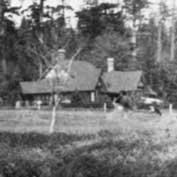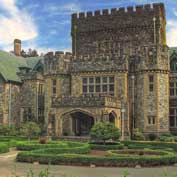Hatleys around the world / 3
By Ishbel Beatty
A country estate in Cambridgeshire gives its name to a settler’s new home on the other side of the world.
The name of Hatley Park was taken to British Columbia in the 1890s for reasons that remain obscure. This surprising fact became known to me when the Municipal Archivist of Victoria, British Columbia, arrived on my doorstep a year or two ago in search of information about Roland Stuart. This was the name of the man who migrated to Vancouver Island and in 1892 acquired 250 acres on the Esquimalt Lagoon, facing south to a breathtaking view of mountains.
There he built himself a Tudor-style house, named it Hatley Park and furnished it with valuable antiques, oil paintings, and a library. He cultivated the land, raised cattle, and supplied ships at the nearby naval station with fresh water. But in 1905 the house burned down and Stuart sold the estate a year or so later.
There is little known about Roland Stuart’s upbringing and his life before his settlement in British Columbia. What was the source of his wealth? How did he come to know of Hatley Park? Why did it seem an appropriate name for his new estate and the house on which he lavished so much care?
From his full name, Gilzean Roland Whateley Stuart, we can guess that Stuart was a Scot. He was born in Little Shelford, but that seems to have been only a temporary address and he and his mother lived later in France. His father, a lieutenant in the Black Watch, died after only a few years of marriage. His mother, Elma, seemed to have little money. She worked at the craft of woodcarving and entered into a fulsome correspondence with a writer for whom she expressed adoration – George Eliot, a literary lion of the day.
Elma visited Marian Evans (George Eliot’s real name) in London, sometimes with her son. Roland did not marry and when his mother died he erected a large obelisk in her memory in Victoria, though she is buried beside George in Highgate Cemetery, her name transformed to Elvorilda Eliza Maria Stuart.
When I look at local directories. I find that our Hatley Park was occupied by tenants at the period before Roland Stuart may have left England; one Alexander Mckenzie in 1875 might conceivably have had a link with the Scottish Stuarts and entertained them there, but I have no clue as to his social status and manner of life.
After Stuart left British Columbia, an ex-Prime Minister of Canada* added even more hundreds of acres to the estate and built himself a grandiose mansion modelled on an Elizabethan manor house. This became Hatley Castle, a family home, working farm, and centre for lavish entertaining. The Castle itself was built with tower and battlements and walls of more than three feet in thickness. The whole was on such a scale that it later became Royal Roads Military Collage, a national university for training officers for 50 years.
Now designated a National Heritage building, the castle is cherished by its own Friends of Hatley Park Society, who have published an anthology of its history. It was Geoffrey Castle, editor of the anthology, who put together the chapters of its early story and came to Hatley St George to see what he could find out about its original owner. He leaves me with a mystery – why did Roland Stuart choose the name of Hatley Park for his property on the other side of the world?
NB. Peter Mann writes: There were no pictures of Hatley Park when Ishbel first published her story; all I could find is the black and white image above, which may not be Hatley Park – the links at the bottom of the page highlight other relevant information. The colour photo is the present building.
Gamlingay Gazette, December 1999
* Update 24 June 2014 – an e-mail from Geli Bartlett:
My name is Geli Bartlett and I am a tour guide at Hatley Park National Historic Site which is currently leased from the Government of Canada by Royal Roads University.
I’m often asked by visitors why it’s called Hatley Park and I tell them that Roland Stuart named it after a place he was fond of in Cambridgeshire.
Having just read some of Ishbel’s correspondence, I’m chastened to find that he’s not known to have lived or even visited there. Hmmm. Then, I have to correct the comment about the next owner of H.P.
James Dunsmuir, elder son of Robert Dunsmuir who was the first millionaire in B.C. (coal and railways), was in turn Premier and then Lt. Governor of B.C. He was never a prime minister of Canada; in fact he loathed politics!
Just thought you might like to know.
By the way, I was researching the Quebec Hatley’s to see if Mr. Stuart was involved in them as he had moved back east after his house burned down in 1905. I’ve lost track of him after 1906.
Cheers,
Geli Bartlett
… and Ishbel’s reply:
Thank you, Geli, for writing about Hatley Park and Roland Stuart. Yes, it seems unlikely that we shall ever know just why the name of Hatley meant so much to Roland Stuart that he transferred it to British Columbia. I am glad that you tried to follow his trail – I too would have liked to know more of him if it had been possible.
Apologies for my misinterpretation of James Dunsmuir’s status. Prompted by your message, I returned to reading Geoffrey Castle’s anthology of HP with much pleasure in all his detailed work.
It’s always nice to know that people are interested in these historic links, and that you personally are doing something to keep them alive in British Columbia today.
Best wishes for your work and interests, and I am so pleased that you took the trouble to communicate.
Ishbel Beatty
- The Roland Stuart residence at Hatley Park.
- Hatley Park National Historic Site.
- From the Archives: Naming Hatley Park.
First published in the Gamlingay Gazette and then on the original Hatley website, 2006; with minor changes for this website plus graphics 11 March 2019. ▲




